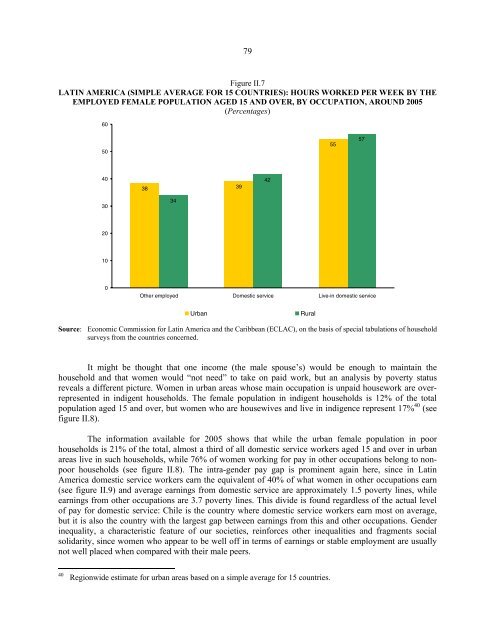Women in Latin America and the Caribbean - Cepal
Women in Latin America and the Caribbean - Cepal
Women in Latin America and the Caribbean - Cepal
You also want an ePaper? Increase the reach of your titles
YUMPU automatically turns print PDFs into web optimized ePapers that Google loves.
79<br />
Figure II.7<br />
LATIN AMERICA (SIMPLE AVERAGE FOR 15 COUNTRIES): HOURS WORKED PER WEEK BY THE<br />
EMPLOYED FEMALE POPULATION AGED 15 AND OVER, BY OCCUPATION, AROUND 2005<br />
(Percentages)<br />
60<br />
50<br />
55<br />
57<br />
40<br />
30<br />
38 39<br />
34<br />
42<br />
20<br />
10<br />
0<br />
O<strong>the</strong>r employed Domestic service Live-<strong>in</strong> domestic service<br />
Urban<br />
Rural<br />
Source: Economic Commission for Lat<strong>in</strong> <strong>America</strong> <strong>and</strong> <strong>the</strong> <strong>Caribbean</strong> (ECLAC), on <strong>the</strong> basis of special tabulations of household<br />
surveys from <strong>the</strong> countries concerned.<br />
It might be thought that one <strong>in</strong>come (<strong>the</strong> male spouse’s) would be enough to ma<strong>in</strong>ta<strong>in</strong> <strong>the</strong><br />
household <strong>and</strong> that women would “not need” to take on paid work, but an analysis by poverty status<br />
reveals a different picture. <strong>Women</strong> <strong>in</strong> urban areas whose ma<strong>in</strong> occupation is unpaid housework are overrepresented<br />
<strong>in</strong> <strong>in</strong>digent households. The female population <strong>in</strong> <strong>in</strong>digent households is 12% of <strong>the</strong> total<br />
population aged 15 <strong>and</strong> over, but women who are housewives <strong>and</strong> live <strong>in</strong> <strong>in</strong>digence represent 17% 40 (see<br />
figure II.8).<br />
The <strong>in</strong>formation available for 2005 shows that while <strong>the</strong> urban female population <strong>in</strong> poor<br />
households is 21% of <strong>the</strong> total, almost a third of all domestic service workers aged 15 <strong>and</strong> over <strong>in</strong> urban<br />
areas live <strong>in</strong> such households, while 76% of women work<strong>in</strong>g for pay <strong>in</strong> o<strong>the</strong>r occupations belong to nonpoor<br />
households (see figure II.8). The <strong>in</strong>tra-gender pay gap is prom<strong>in</strong>ent aga<strong>in</strong> here, s<strong>in</strong>ce <strong>in</strong> Lat<strong>in</strong><br />
<strong>America</strong> domestic service workers earn <strong>the</strong> equivalent of 40% of what women <strong>in</strong> o<strong>the</strong>r occupations earn<br />
(see figure II.9) <strong>and</strong> average earn<strong>in</strong>gs from domestic service are approximately 1.5 poverty l<strong>in</strong>es, while<br />
earn<strong>in</strong>gs from o<strong>the</strong>r occupations are 3.7 poverty l<strong>in</strong>es. This divide is found regardless of <strong>the</strong> actual level<br />
of pay for domestic service: Chile is <strong>the</strong> country where domestic service workers earn most on average,<br />
but it is also <strong>the</strong> country with <strong>the</strong> largest gap between earn<strong>in</strong>gs from this <strong>and</strong> o<strong>the</strong>r occupations. Gender<br />
<strong>in</strong>equality, a characteristic feature of our societies, re<strong>in</strong>forces o<strong>the</strong>r <strong>in</strong>equalities <strong>and</strong> fragments social<br />
solidarity, s<strong>in</strong>ce women who appear to be well off <strong>in</strong> terms of earn<strong>in</strong>gs or stable employment are usually<br />
not well placed when compared with <strong>the</strong>ir male peers.<br />
40<br />
Regionwide estimate for urban areas based on a simple average for 15 countries.











